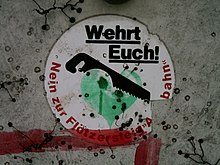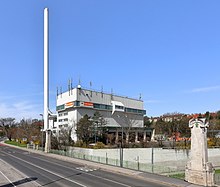Flötzersteig Street
| State road B223 in Austria | |
| 223 | |
| map | |
| Basic data | |
| Overall length: | 4.8 km |
|
State : |
|
The Flötzersteig Straße B223 is a main road B and former federal road in the west of Vienna , which leads through the districts 14 ( Penzing ) and 16 ( Ottakring ). The street is considered to be the "second west entrance or exit" (next to Wiener Straße ) ( B 1 ). The street number 223 is only partially signposted. The name is derived from a historical traffic route from Alsergrund through Ottakring, on which the Flötzer (raft drivers) hiked back on foot after unloading the cargo.
course
The B223 leads from a common route over the streets Flötzersteig, Joachimsthalerplatz, Wernhardtstraße, Gutraterplatz, Spetterbrücke and Gablenzgasse and then as separate one-way streets over Pfenninggeldgasse and Koppstraße (out of town) or Gablenzgasse (inward) to Lerchenfelder Gürtel (B221).
history
A road bridge was built over the Ameisbach as early as 1908, and in 1965 a pedestrian bridge was built at the highest point of the ascending road. A tram line (47) operated on the Flötzersteig until the 1960s , but it was discontinued in line with the zeitgeist of the time and replaced by a bus line (today 48A). The Flötzersteig street belonged from 1 September 1971 for the network of federal roads in Austria . Like most of the federal highways at that time, Flötzersteig Straße was handed over to the City of Vienna by the federal government in 2002.
The planned Flötzersteig "Autobahn"
The street caused a sensation in the 1970s and 1980s, when the expansion of the western section from Tinterstraße to Hütteldorf and on to the West Autobahn as an elevated road, otherwise known as the “Flötzersteig Autobahn”, was planned. The B 223 ends before Hütteldorf and you can only get there by subordinate streets in the direction of the West Autobahn. It was hoped that the new connection would result in a better flow of traffic. The construction project was also promoted by the SPÖ politician Heinz Nittel , who at the time headed the “Road, Transport and Energy” business group at the City of Vienna.
One of the then relatively frequent Viennese referendums with complicated questions and therefore unclear results was held on the project from March 16 to 18, 1980 . The Viennese were able to opt for a Flötzersteig extension as a Stelzenstraße, with a level crossing of Linzer Straße or without specification: 28.9% of those eligible to vote took part in the survey, of which a majority of 56.6% voted for one of the specified variants of the extension. The proponents saw the result as a “majority for the second western entrance to Vienna”, but the opponents claimed that a majority had decided against the stilt road project preferred by the community. Due to ongoing protests from the population, the project was finally no longer pursued. Nevertheless, the plans have not yet been officially rejected, they have occasionally appeared in general plans in recent years and are also included in the current main street directory of the City of Vienna as "New route to B 1". However, since construction seems unlikely and would probably meet with resistance even today, the corresponding citizens' initiative dissolved around the year 2000.
Surroundings
The Wilhelminenspital is located along the Flötzersteig . The term Flötzersteig often also refers to the Flötzersteig waste incineration plant or the nearby residential area (Flötzersteig settlement). The road is partially developed with two lanes in each direction, the outer two of which are now mostly used as a parking lot. Over the rising green area of Raimannstraße you can see up to the entrance and the administration building of the Steinhof / Baumgartner Höhe hospital .
Individual evidence
- ^ Announcement by the Federal Minister for Buildings and Technology of October 17, 1973 in accordance with Section 33 (4) of the Federal Roads Act 1971 with regard to the State of Vienna. Federal Law Gazette No. 545/1973 .
- ^ First referendum: Respectable demonstration of direct democracy. Majority for the second western entrance to Vienna . In: Arbeiter-Zeitung . Vienna March 20, 1980, p. 1 ( berufer-zeitung.at - the open online archive - digitized).
| B223 | Like the other former federal highways, Flötzersteig Straße was part of the federal administration. Since April 1, 2002, it has been under state administration and continues to have the B in the number, but not the name Bundesstraße. |
Coordinates: 48 ° 12 ′ 28 " N , 16 ° 17 ′ 51" E



